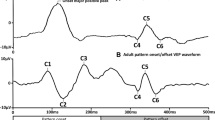Abstract
The potentials evoked by pattern reversal stimulation (2/sec, 11° field, 26′ high contrast checks) are described in 22 patients with intracranial space-occupying lesions lying posterior to the optic chiasm. Seventeen (77%) of these patients had clinically demonstrable visual field defects. The nature and position of the lesion was defined by CT scan, by cerebral angiography, or at operation. Completely normal pattern visual evoked potentials (VEPs) were recorded in four patients (18%), all of whom had full visual fields. Definitely abnormal VEPs occurred in 12 patients (55%), 11 with visual field defects. The remaining six patients (27%), all with visual field defects, had VEPs that were inconsistently abnormal and they are rated as equivocal. The findings are discussed with particular attention to the importance of stimulus and recording parameters.
Similar content being viewed by others
References
Arruga J, Feldon SE, Hoyt WF and Aminoff MJ: Monocularly and binocularly evoked visual responses to patterned half field stimulation. J Neurol Sci 46:281–290 1980.
Barrett G, Blumhardt LD, Halliday AM, Halliday E and Kriss A: A paradox in the lateralisation of the visual evoked response. Nature 261:253–255 1976.
Blumhardt LD and Halliday AM: Cortical abnormalities and the visual evoked response. Doc Ophthalmol Proc Series 27:347–365 1981.
Blumhardt LD, Barrett G, Kriss A and Halliday AM: The pattern-evoked potential in lesions of the posterior visual pathways. Ann NY Acad Sci 388:264–289 1982.
Camacho LM, Wenzel W and Aschoff JC: The pattern reversal visual evoked potential in the clinical study of lesions of the optic chiasm and visual pathway. In Courjon J, Mauguiere F and Revol M (eds.). Clinical Applications of Evoked Potentials in Neurology, pp 49–59. Raven Press, New York, 1982.
Chain F, Lesevre N, Pinel JF and Leblance M: Spatio-temporal study of visual evoked potentials in patients with homonymous hemianopia. In Courjon J, Mauguiere F and Revol M (eds.). Clinical Applications of Evoked Potentials in Neurology, pp 61–70. Raven Press, New York, 1982.
Halliday AM, Halliday E, Kriss A, McDonald WI and Mushin J: The pattern evoked potential in compression of the anterior visual pathways. Brain 99:357–374 1976.
Halliday AM, Harding GFA and Holder GE: Discussion on the lateralisation of pattern VEP in homonymous field defects. In Barber C (ed.). Evoked Potentials, pp 292–298. MTP Press, Lancaster, 1980.
Harding GFA, Smith GF and Smith PA: The effect of various stimulus parameters on the lateralisation of the VEP. In Barber C (ed.). Evoked Potentials, pp 213–218. MTP Press, Lancaster, 1980.
Holder GE: The effects of chiasmal compression on the pattern visual evoked potential. Electroencephalogr Clin Neurophysiol 45:278–280 1978.
Holder GE: Abnormalities of the pattern visual evoked potential in patients with homonymous visual field defects. In Barber C (ed.). Evoked Potentials, pp 285–291. MTP Press, Lancaster, 1980.
Holder GE: The visual evoked potential in ischaemic optic neuropathy. Doc Ophthalmol Proc Series 27:123–129, 1981.
Kuroiwa Y and Celesia GG: Visual evoked potentials with hemifield pattern stimulation. Their use in the diagnosis of retrochiasmatic lesions. Arch Neurol 38:86–90 1981.
Lesevre N and Joseph JP: Modifications of the pattern evoked potentials (PEP) in relation to the stimulated part of the visual field (clues for the most probable origin of each component). Electroencephalogr Clin Neurophysiol 47:183–203 1979.
Samson-Dollfus D, Parain D, Weber J, Menard JF, Mihout B and Vachon B: The visually evoked potential in retrochiasmatic lesions of the optic pathways: an attempt to interpret the responses obtained by flash pattern stimulation and the results of the calculation of the correlation coefficient between visually evoked potentials. In Courjon J, Mauguiere F and Revol M (eds.). Clinical Applications of Evoked Potentials in Neurology, pp 71–70. Raven Press, New York, 1982.
Shagass C, Amadeo M and Roemer RA: Spatial distribution of potentials evoked by half-field pattern reversal and pattern onset stimuli. Electroencephalogr Clin Neurophysiol 41:609–622 1976.
Streletz LR, Bae SH, Roeshman RM, Schatz NJ and Savino PJ: Visual evoked potentials in occipital lobe lesions. Arch Neurol 38:80–85 1981.
Author information
Authors and Affiliations
Rights and permissions
About this article
Cite this article
Holder, G.E. Pattern visual evoked potential in patients with posteriorly situated space-occupying lesions. Doc Ophthalmol 59, 121–128 (1985). https://doi.org/10.1007/BF00160608
Issue Date:
DOI: https://doi.org/10.1007/BF00160608




